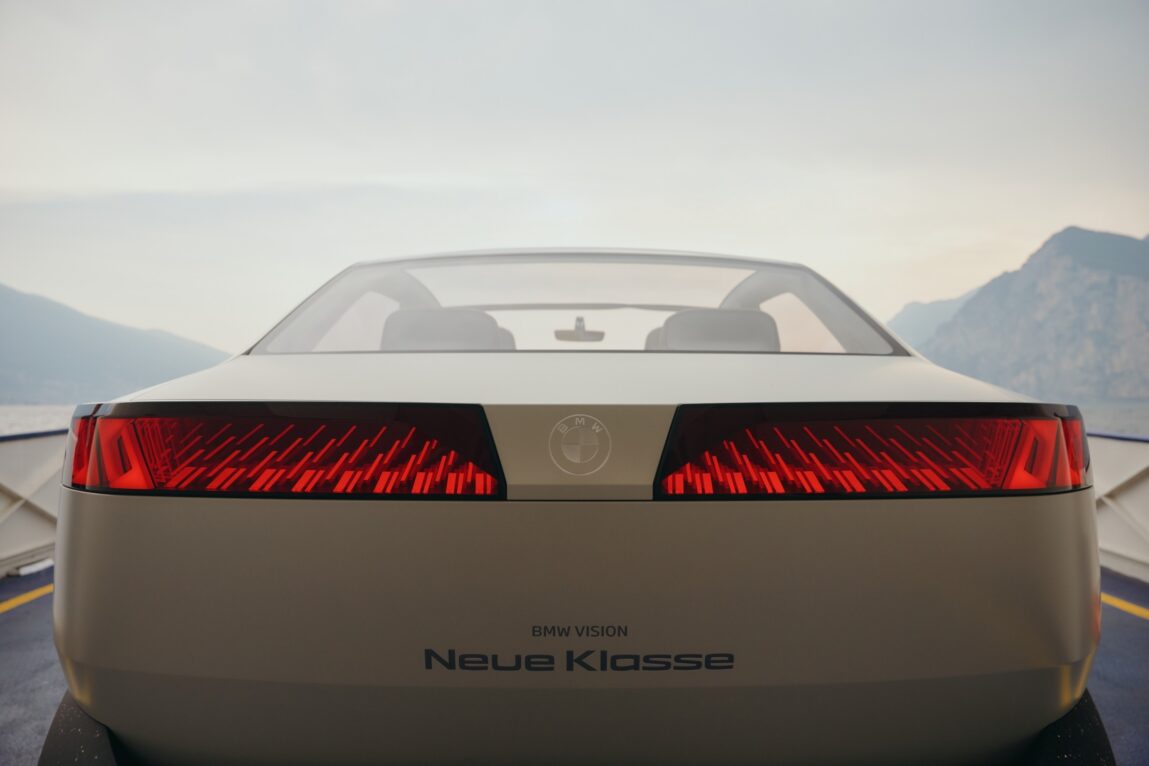The start of a new era: The Vision Neue Klasse, which was presented at the beginning of September, provides a preview of the future design language of all BMW models. Despite its optical exaggeration, which is typical of a Vision vehicle, it is also intended to actually show the new BMW design philosophy, including specific design elements, which will be characteristic of all subsequent Neue Klasse models from 2025 onwards. The vehicle is also intended to reflect the brand’s innovative strength in terms of electrification, digitalization and circularity.
Not just a new chapter, a completely new book is being opened with this vision vehicle, BMW announced at the presentation of the Vision Neue Klasse in Munich. And indeed – the almost monolithic vehicle body, the strong recesses at the front and rear, or even the large window areas show a new, very bold and especially also futuristic-elegant aesthetic – even if classic BMW characteristics such as the recessed greenhouse, the »Shark Nose«-style vehicle front protruding far forward or the »Hofmeister-Knick« are still retained or even more strikingly presented.
»On the one hand typical BMW and at the same time so progressive that it looks as if we have skipped a model generation», is how Adrian van Hooydonk, Head of BMW Group Design, whom Chapter met for an interview directly after the world premiere of the Vision Neue Klasse, describes it. We talked to him about the courage to seek out too much change in design, the role of AI in automotive design, and why designers need particularly fine antennae for future trends and developments.
(Note: The interview was conducted in German and translated into English)
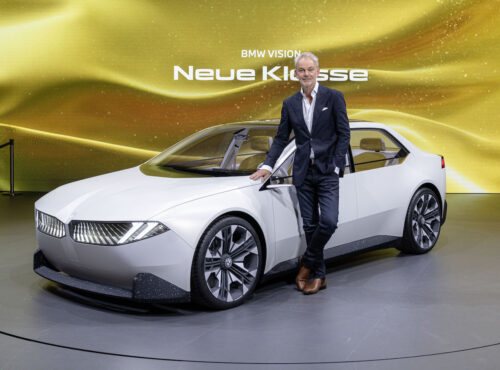
Chapter Today, we have witnessed perhaps the greatest transformation in BMW’s design and have been given a first glimpse of the future design language of all models. But to what extent are such design studies presented in advance also a kind of »provocation« – meant in the most positive sense, of course – in other words, a testing of reactions, for example, to evaluate whether consumers’ perceptual habits are already ready for new proportions or design approaches?
Adrian van Hooydonk Well, we naturally try to take a little more freedom with a show car or vision vehicle than we have in series production. And for good reason, because that naturally stretches the perception of what a brand can or »may« do. But provocation wasn’t really in the foreground here, that wasn’t in the catalogue of goals, if you will. Of course, we also want to do a bit of testing and preparation, because the Neue Klasse will actually be implemented and there will actually be these big leaps in technology and in design. We believe that this is necessary because the times around us are simply changing so quickly and so strongly – and now we see the moment has come to take somewhat bigger steps, and also in the core of the brand. For example, we already designed an i3 and i8 almost 15 years ago, and they were also progressive, if you will. But those were more additions that happened on the fringes of our product line. Now, on the other hand, we’re talking about the core of the brand, not just a couple of products on the fringe, because we’re going to roll out the Neue Klasse across the entire product range. And we also deliberately chose a sedan for this vision car because it’s so typical of the BMW brand – when you show a sedan, that’s the best way to explain how big the changes would be or what kind of changes we’re aiming for. Those have been the goals – so not necessarily provocation, but already a bit of softening of what is understood or known as BMW and a preparation for what is to come.
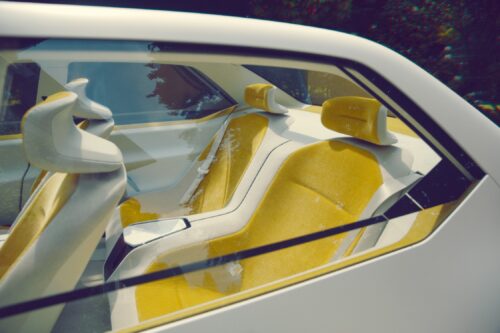
Chapter I remember a quote from you the last time we talked, namely that in the current time it would be a greater risk to look for too few changes in the design than perhaps to implement too much at times. Related to the Neue Klasse – are there specific elements where your design team may have deliberately »risked« a bit too much bold change?
Adrian van Hooydonk So I still stand by that quote today. And as I mentioned, a concept or vision car is also allowed to exaggerate a bit, it doesn’t have to fulfill all the laws. But it is still too early to evaluate the reactions to this concept. We have already tried to pay attention to the initial feedback, but it will take a few days, maybe even weeks, before we can draw a conclusion. And yes, of course we know ourselves where we have perhaps deliberately exaggerated and where we will be a little different in series. And now, of course, we’ll know even better in a few weeks whether we’re on the right track.
Chapter In the current print edition of Chapter, our author Prof. Lutz Fügener asks why automotive design has been inspired so little by the Bauhaus. Today’s look at the design language of the Neue Klasse with its clear surfaces without beading, almost monolithic in appearance, brought this article to mind – one could almost speak of Bauhaus aesthetics in the design of the Vision Neue Klasse …
Adrian van Hooydonk Well, thank you, of course we are honored by that, but of course everyone has to interpret that for themselves. But what we definitely wanted to do is a design that is very clean, because we believe that this naturally also has a modern effect, but it is also more durable, because we also want this generation of vehicles to run longer than the previous ones, which also makes sense in terms of sustainability. And at the same time, we are trying to simplify the design not only because we like the look of it, but also in order to have significantly fewer components, because a car today is already very small – both in the interior and in the exterior – and we are trying to counteract this here. And yet we want our customers, our fans, to clearly recognize a BMW as such, even if we use fewer means to do so: Among other things, very few lines – and that is perhaps something that is also similar to Bauhaus. Nevertheless, we don’t want it to look static, because of course it’s a product on four wheels that can move under its own power.
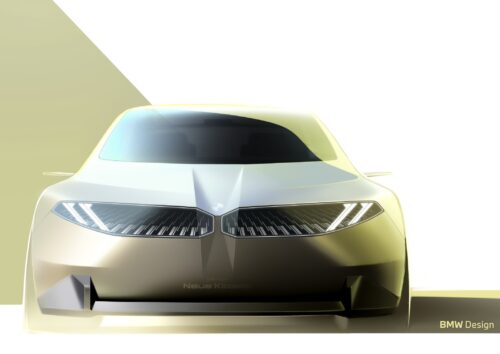
Chapter Now, a design team designs and plans several years in advance and therefore has to anticipate many future developments: How the market changes, society, culture, architecture and so on. Can you give us a little insight into the day-to-day work of the design team, how long do you have to look ahead and what market research data or other forecasting tools can you use for this?
Adrian van Hooydonk So in 2023, we are currently working on products that will come to market in 2026/27. We have to decide or define them in the design this year, after all they will come out and then they will be on the market for about seven to eight years. In other words, we are already working on products that will still be on the market in 2033/34. And there is actually no market research on this. Of course, there are trend analyses that can be done, even in fashion, for example, but they don’t look that far ahead, maybe a year or so.
Chapter So is this anticipation that you’re talking about largely the talent of a designer?
Adrian van Hooydonk I would say yes, or at least it should be part of the skillset that you need to have. Of course, with our design we try to anticipate things that are going to happen in society, and it’s often the case that these things are foreshadowed. If you have fine antennae, you already perceive them, even if they are not yet ubiquitous. So let’s say, you have to have these fine antennae, that’s helpful.
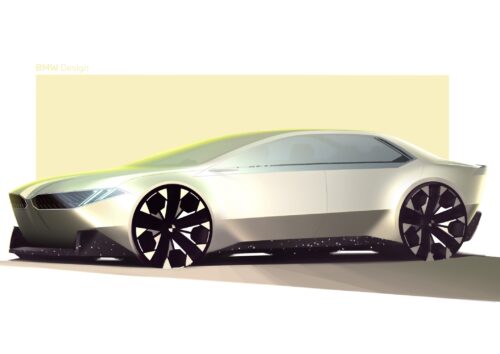
Chapter Can you perhaps describe this in more detail using a current, concrete example?
Adrian van Hooydonk For example, the area of artificial intelligence – there is currently a lot of discussion and thought about this, and here it is of course also important for us not to chase after every hype, but to distill out of this multitude of developments what could really be relevant to us, for our product category and customers, and what could this lead to? Because many developments can of course lead to things that do not yet exist today, but which will be very normal in five years’ time. And here it is very important to anticipate this. That’s not always easy, of course, but I also often say that if you can imagine something, then these days you also have a very good chance that it will actually happen. And something else that helps us, I think, is our worldwide studios (ed. note: DesignWorks), in Shanghai, Los Angeles, Munich, England, because changes and the speed of those changes are quite different in different regions: The topic of digitalization is developing much faster in China than here, some things are already normal there that we haven’t even seen here yet. The issue of sustainability, on the other hand, is perhaps more of a European issue; Europe is very progressive in this respect, at least in terms of thinking. And then, of course, America is traditionally a country where there are actually no limits to change, »change is always good«… and so you can see a few new players coming in now that are definitely producing interesting things. In addition, you have to be creative, of course, and also design several scenarios, depending on how you think the world could develop, and try to create appropriate designs that can fit the respective scenarios. And then you discuss in the team, how likely is this or that scenario and how attractive do we find the solution based on it? And only then you go into the implementation and the deeper elaboration of the design. But, of course, it also has a lot to do with risk and taking a position. Because if you wait until you know exactly what’s going to happen, you’re usually too late. At some point you have to make some decisions and have the courage to say, we believe that this and that is right for the BMW brand, and that’s exactly how this vision vehicle came about.
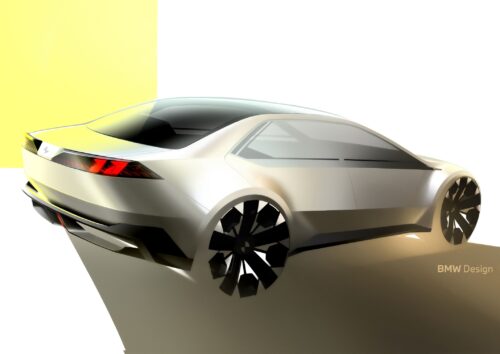
Chapter Because the topic of AI has come up, what role can artificial intelligence play in this forecasting process or in automotive design in general?
Adrian van Hooydonk Well, I think human creativity is hard to top. Of course, in automotive design, many designers are already using AI as well. But ultimately, what does AI do? It siphons off the entire internet and then combines that with a few keywords that you’ve entered. And somehow the result seems new, but also strangely familiar. And that’s not surprising because it’s based on that suction of everything that’s already out there. So I would say that people, we designers, have all this in our heads as well, as a kind of database. And then there is the issue of creativity when we draw. And I always tell my designers that you shouldn’t always evaluate the result immediately, but just draw for a week and then at the end of the week think about what you’ve created – and then you’ll immediately recognize that this is new and that isn’t, that reminds you of something else that already existed. And well, AI may speed up this process, it can make 100 sketches overnight, but are they all good? No, you have to sort out a lot. So it’s still difficult to say where the development will lead, I think ultimately, the human being is still the decisive factor – first with AI, which parameters do you introduce, and then, secondly, in the decision-making process. I think this will never be automated, a computer will not be able to determine whether with this design you will be the winner. [CS]

